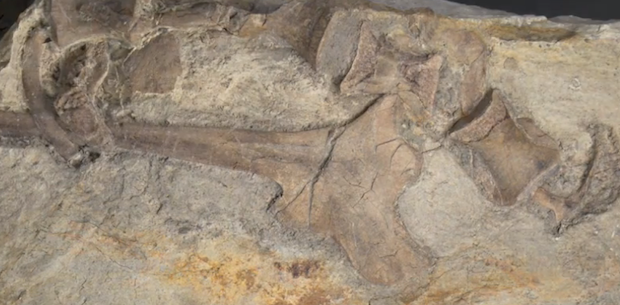Meat-eating T. rex relative found on Wales beach
Amateur dinosaur hunters on a storm-battered beach in Wales have discovered the fossilized skeleton of a meat-eating relative of Tyrannosaurus rex.
This new species of theropod - which has yet to be named - lived in the earliest part of the Jurassic period around 201 million years ago, possibly making it one of the oldest dinosaurs in the world.
"It was the most beautiful little fossil I'd seen in a very, very long time," University of Portsmouth's David Martill, who works mainly with pterosaurs, theropod dinosaurs and exceptional preservation of fossil vertebrates, said of the find.
"Dinosaur remains are really rare. This animal is the very first dinosaur from the Jurassic of Wales," he said. "There are few scrappy bits of pieces from the Triassic, slightly older rocks but this is just inside the Jurassic."
The discovery was made by brothers Nick and Rob Hanigan whilst fossil hunting along the Lavernock beach in the Vale of Glamorgan following storms in the spring of 2014. After a cliff collapsed on the beach, they spotted several loose blocks containing part of the skeleton of a small dinosaur and collected the specimens, including its razor sharp teeth and claws.
They later donated it to the National Museum Cardiff, which began displaying the dinosaur Tuesday.
"Finding the skull of the dinosaur was absolutely fantastic," Nick Hanigan said in a video accompanying news of the dinosaur exhibition. "To see that skull being prepared and see the teeth of a theropod for the first time in 200 million years, you just can't beat that kind of thing."
In analyzing the bones and teeth, researchers at the museum as well as the University of Portsmouth and the University of Manchester concluded it was a meat-eating dinosaur from the theropod group that lived near the sea at a time when the climate of Wales was more like the Mediterranean.
It is related to another theropod - Coelophysis - that lived approximately 203 to 196 million years ago in what is now the southwestern part of the United States.
The researchers believe it was a juvenile animal, which stood about a foot-and-half tall and had a long tail to help keep its balance. It was most likely warm-blooded dinosaur with a coat of feathers for insulation and quill-like structures for defense. It also had lots of small, blade-like, sharp, serrated teeth, allowing it to eat insects, small mammals and other reptiles
"It was ferocious," Martill said. "Its mouth was lined with tiny little needle sharp teeth curved backwards with serrated steak knife edges on them."
Martill said "one of the great things" about the discovery was how the skeleton was more than just a pile of bones.
"Most dinosaurs are made from very scrappy material," he said. "We've got about 40 percent of the skeleton of this one, some of the bones from the left side. We perhaps don't have the right side but we can make them from mirror images."
With so much of the skeleton, Martill said it should shed light on the evolution of meat-eating dinosaurs.
"It's from a period of time when we know that the meat-eating dinosaurs were diversifying and there are hardly any new specimens," he said.
Researchers expect this part of Wales may yield other discoveries, especially species like prehistoric crocodiles and other reptiles that lived alongside this dinosaur. But they said it was unlikely they would come upon another theropod anytime soon.
"This is a once in a lifetime find and I suspect we'll have to wait many, many more years before we find another one," Martill said.
